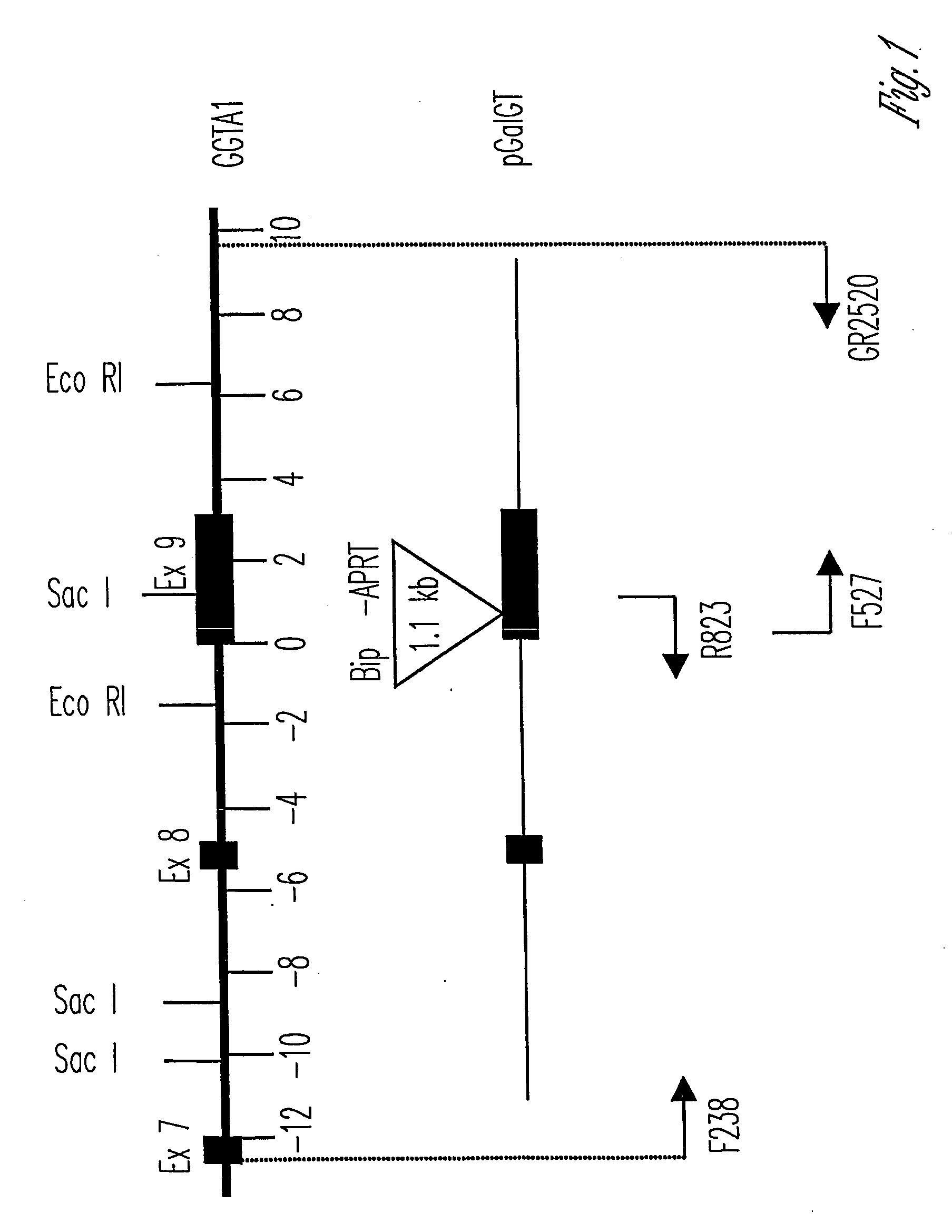Knockout swine and methods for making the same
a knockout swine and knockout technology, applied in the field of nonhuman animal genetic manipulation, can solve the problems of limited human, partial reduction of gal epitopes, and limitation of the ability to provide organs to patients in need of transplantation
- Summary
- Abstract
- Description
- Claims
- Application Information
AI Technical Summary
Benefits of technology
Problems solved by technology
Method used
Image
Examples
example 1
Generation of Knockout Primary Fetal Porcine Cells
[0058] A highly inbred, MHC-defined miniature pig line, descendent from lines long used for xenotransplantation studies was used (see D. H. Sachs et al., Transplantation 22, 559 (1976)). This line is an ideal size-match for eventual use in clinical transplantation and has animals that consistently test negative for transmission of porcine endogenous retrovirus (PERV) to human cells.
[0059] Cells were isolated from 1 male (F9) and 3 female (F3, F6, F7) fetuses at day 37 of gestation for production of donor cell lines. Primary fibroblasts were isolated by collegenase / trypsin digestion of minced tissue. Dissociated cells were plated at 2×105 cells / cm2 on collagen-coated plates in Ham's F10 medium containing 20% FBS and antibiotics. Adherent cells were frozen the following day.
[0060] The fibroblasts were thawed at 370° C., and 200 μl fetal calf serum (FCS) was added. The cells were then cultured for 3 days to subconfluence prior to tra...
example 2
Nuclear Transfer into Enucleated Oocytes
[0066] Oocytes derived from slaughtered gilts were matured in defined protein medium (TCM 199 supplemented with 0.1% PVA 0.1 mg / ml cysteine, 10 ng / ml EGF, 0.91 mM Na-pyruvate, 3.05 mM D-glucose, 0.5 μg / ml FSH, 0.5 μg / ml LH, 75 μg / ml penicillin, 50 μg / ml streptomycin). Oocytes from sow ovaries were purchased from BioMed, Inc. (Madison, Wis.) and shipped in maturation medium (TCM 199-Hepes, supplemented with 5 μg / ml insulin, 10 ng / ml EGF, 0.6 mM cysteine, 0.2 mM Na-pyruvate, 3 μg / ml FSH 25 ng / ml gentamycin and 10% porcine follicular fluid) overnight. Porcine follicular fluid was collected from follicles of 3 to 6 mm diameter, centrifuged at 1500×g for 30 minutes at 4° C., filtered through 1.2 μm syringe filters and stored at −20° C. until use. Nuclear transfer was performed using in vitro matured oocytes and, except for 4 transfers noted in Table 2, cryopreserved donor cells without further culture. After 42 to 44 h of maturation, oocytes were ...
example 3
Transfer of NT-Derived Embryos to Mated Surrogates
[0067] Potential surrogates were checked for estrus twice a day. Depending upon the exact time of estrus, NT-derived embryo transfers were performed 5-17 hours or 20-36 hours following the actual onset of estrus for day 0 and day 1 surrogates, respectively. In prior control experiments using in vitro-produced embryos cultured for 22 hours following fertilization and then transferred to a day 1 surrogate, 19 of 100 embryos recovered on day 6 were at blastocyst stage, with an average nuclear number of 65. For surgery, gilts were pre-anesthetized with Pentothal® (Abbott Laboratories, North Chicago, Ill.) and anesthesia was maintained with 2% Halothane (Halocarbon Laboratories, River Edge, N.J.). A midventral laparotomy was performed, embryos loaded into a tomcat catheter and deposited into the oviduct. Benamine (flunixin meglumine, 1.5 ml IM) was administered to the surrogate during the surgery. Examination of the ovaries during embryo...
PUM
| Property | Measurement | Unit |
|---|---|---|
| Fraction | aaaaa | aaaaa |
| Fraction | aaaaa | aaaaa |
| Fraction | aaaaa | aaaaa |
Abstract
Description
Claims
Application Information
 Login to View More
Login to View More - R&D
- Intellectual Property
- Life Sciences
- Materials
- Tech Scout
- Unparalleled Data Quality
- Higher Quality Content
- 60% Fewer Hallucinations
Browse by: Latest US Patents, China's latest patents, Technical Efficacy Thesaurus, Application Domain, Technology Topic, Popular Technical Reports.
© 2025 PatSnap. All rights reserved.Legal|Privacy policy|Modern Slavery Act Transparency Statement|Sitemap|About US| Contact US: help@patsnap.com



